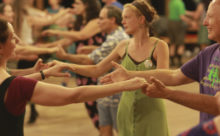"Daniel J. Walkowitz, City Folk: English Country Dance and the Politics of the Folk in Modern America (New York University Press, 2010)" by April F Masten
I once took my history class to an eighteenth-century inn to experience English country dancing. As the night progressed, one burly, overly exuberant student roared “GAZEBO!” as the dancers rushed to form an arbor of hands held aloft. Afterward, the unsmiling silver-haired caller chastised the group. I never fully understood why until reading Daniel J. Walkowitz’s City Folk, a sweeping account of the revival of English country dance (ECD) in twentieth-century Britain and America.
To Walkowitz, ECD embodies “the culture of liberalism” - a slippery concept that seems to mean the effort of bourgeois urbanites to improve society through cultural reforms (p. 5). He situates ECD’s revival in the historiography of Progressivism and its transatlantic project to Anglicize, Americanize and rationalize the immigrant, industrial working-class body. The book serves as an affectionate biography of a country-dance kingpin, an expose of the cut throat nature of cultural institution building, and a polemic on the consequences of resisting change.
Part 1 traces ECD from its first revival in the 1890’s as an “invented” tradition to its professionalization in the 1920’s (p. 153). Country dancing was a form of group sociability enjoyed at rural and village assemblies by the “peasant” classes. It was brought to the city by an elite group of reformers and patrons intent on pitting the recuperative power of folk traditions against the depravities of modern culture, with its promiscuous and radicalized dances and dance halls. Chief among them was the English folklorist Cecil Sharp who ruthlessly sanitized the dances he collected in rural England and Appalachia to match his notion of historical authenticity. This idealized country dancing was characterized by the “gay simplicity” of smooth formal movements (p. 2). Challenged by suffragists and male dancers more sympathetic to the varied and raucous steps of the “folk,” Sharp consolidated his authority in England and America by attracting a coterie of female disciples, establishing a system of teacher certification and erasing aesthetic and financial rivals from ECD history.
Part 2 follows ECD’s second revival from the Great Depression to the 1970’s, when it peaked alongside the international folk dance movement as an alternative cultural practice. Membership dwindled in the 1980’s due to competition from booming contra and Celtic dance societies and ECD’s essentially stodgy style of dance and deportment. The only new demographic to join the group was affluent white ethnic Americans, who now embraced Anglo-American heritage as their own. In the 1990’s romantic representations of English country dancing in movie adaptations of Jane Austin novels piqued the interest of younger dancers, but the community remained largely aloof from working people and minorities. Unapologetically retro, ECD entered the twenty first century as a safe haven for aging hippies seeking recreation outside the materialist “speed-and-greed” culture of modern society. This restricted space, says Walkowitz, defined “modern liberal culture” (p. 7).
While providing a serious critique of this overlooked cultural practice, City Folk often reads like the work of a die-hard enthusiast. Walkowitz concludes with a call for yet another revival that will attract youth by incorporating folk dances with hip thrusts, reflecting centuries of cultural exchange between blacks and whites. But ECD was reinvented to stand against such dialectical transformations. Its appeal, however limited, lies in its orderly sociability and pseudo-historicity. Ultimately, Walkowitz, like Sharp, sees English country dance as an endangered tradition still in need of rescue from its past.
April F. Masten
State University of New York
Stony Brook, New York
The Journal of American History, Vol. 98, No. 3 (December 2011), pp. 918-919
